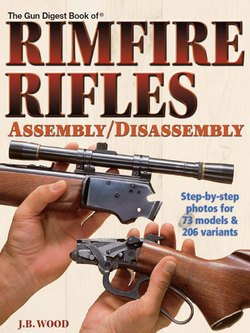Читать книгу The Gun Digest Book of Rimfire Rifles Assembly/Disassembly - J.B. Wood - Страница 41
На сайте Литреса книга снята с продажи.
ОглавлениеDisassembly:
1. Cycle the action to cock the internal hammer, and set the safety in on-safe position. Remove the inner magazine tube. The tube can be taken apart (see note at end of Tool Section), but in this gun it would require pulling a non-through retaining pin. In normal takedown, it is best left intact. Remove the cross-screw in the barrel band at the front of the forend, and move the band off toward the front. If it is tight, nudge it with a non-marring drift.
2. Remove the large screw in the underside of the forend.
3. Remove the forend downward.
4. Drift out the small cross pin at the lower front of the receiver.
5. Move the bolt handle slightly toward the rear, and tip the trigger group downward at the front. The bolt will disconnect from the cocking handle assembly.
6. Move the trigger group slightly forward, and remove it downward from the receiver.
7. Move the cocking handle assembly forward to clear its track in the receiver, and push it inward, to be taken out the bottom of the receiver. Do not attempt to take it out through the ejection port.
8. Move the bolt rearward until it clears the ejector, and lift it off the trigger group.
9. The cocking handle and bolt spring assembly is riveted at the rear, and in normal takedown it should be left intact.
10. The firing pin has no return spring. For removal, drift out the cross pin toward the left side.
11. To remove the extractor, insert a small tool to push the spring plunger rearward, and lift the extractor out of its recess. CAUTION: Control the plunger and spring, and ease them out.
12. The roll-pin in the lower edge of the bolt is only a bearing pin for the cartridge lifter, and it need not be removed in normal takedown.
13. Remove the ejector plate from the left side of the trigger group.
14. Move the safety to off-safe position, restrain the hammer, pull the trigger, and ease the hammer down to fired position. Unhook the disconnector springs (one on each side) and allow them to go over toward the rear. (Note: The Colt parts list calls the disconnector the “sear bar”)
15. Remove the disconnector cross pin toward either side.
16. Restrain the sear, and remove the sear cross pin toward either side.
17. Move the disconnector slightly rearward, and take it off upward.
18. Tip the sear over toward the front, and remove it through the side opening.
19. Remove the sear plunger and spring.
20. If necessary for repair, the disconnector springs can be removed by prying out their mounting posts on each side. These are usually fitted very tightly, so routine removal is inadvisable.
21. Drift the hammer spring pin alternately toward each side, just far enough to allow unhooking the spring. CAUTION:Even with the hammer in fired position, the spring is under tension, so control it. When it is unhooked on both sides, move the spring to the rear and turn it for removal.
22. Drift out the cross pin that pivots and retains the hammer and trigger, and remove the hammer upward. Note: Drift out this splined pin toward the left side.
23. Drift out the hammer stop pin toward the left, and remove the trigger upward. As with all pins that are splined, check to be sure that some previous disassembly has not reversed them.
24. When the trigger is removed, be sure the small nylon bushings are still present in both sides at the pivot point. If not, retrieve any missing bushing from inside the trigger group.
25. The trigger spring is mounted at the center on the hammer spring cross pin, and drifting out the pin will free it for removal, if necessary.
26. Drifting out these two pins will free the two sides of the cartridge feed throat for removal upward. In normal takedown, this system is best left in place.
27. Removal of the feed throat assembly will allow the cartridge lifter to pivot over rearward, easing the tension of its spring. The lifter and its spring are retained by this cross pin. Do not attempt to remove the lifter and spring without first taking off the feed throat assembly. (It is still in place here.)
28. If removal of the safety is necessary, insert a very small tool through the access hole in the safety to depress the detent plunger, and move the safety out toward the left side. Caution: The plunger and spring will be released as the safety clears, so take care that they are not lost. The tool used must have an offset tip with a reach of at least 5.16-inch. A dental tool is being used here. The hole is accessible only with the button in off-safe position.
29. The barrel is retained in the receiver by a large roll-pin. If removal is necessary, after the pin is drifted out grip the barrel in a padded vise and use a hammer and a block of hardwood to drive the receiver off the barrel.
30. The outer magazine tube is best left in place, but if it must be removed, take out the cross-screw and take off the forward barrel band.
31. The front sight is retained by two vertical screws. The dovetail-mounted rear sight is drifted out to the right. The buttstock is retained by a through-bolt from the rear, accessible by taking off the buttplate.
